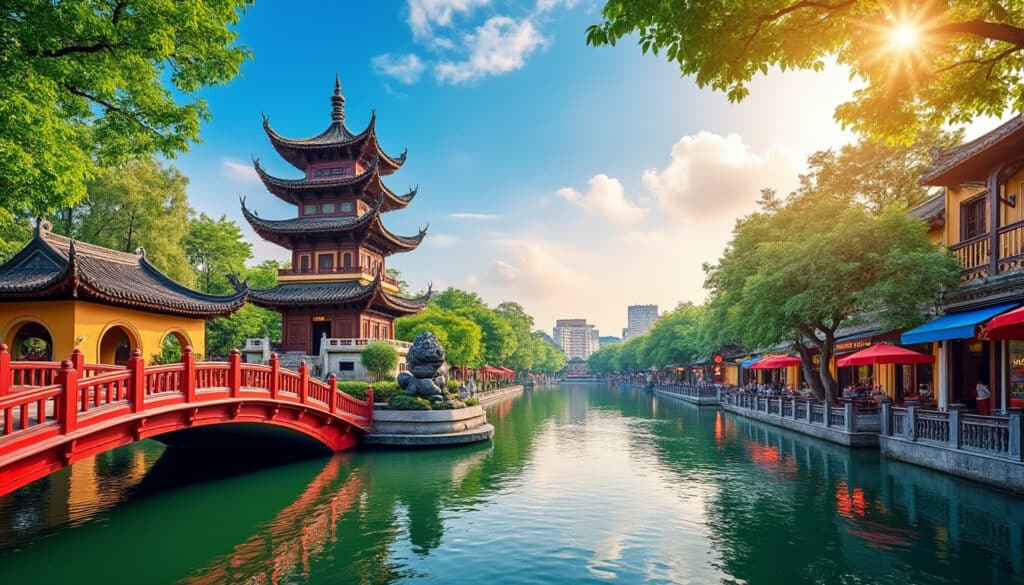In the heart of Vietnam, Hanoi stands as a testament to the cultural and historical richness that has evolved over millennia. The names, flags, and identity of this vibrant city are not just labels or symbols, but threads woven into the intricate cultural tapestry that defines the Vietnamese spirit. From its ancient titles to its iconic landmarks, Hanoi’s evolution in names and emblems tells a story of resilience, transformation, and pride. This exploration delves into the myriad facets of Hanoi’s identity, illuminating how this city embodies unity in diversity.
The Evolution of Hanoi’s Names Through History
The journey of Hanoi’s names is like tracing the essence of a historical epic, reflecting the layers of its cultural and political evolution. The city was initially called Thăng Long, which means “ascending dragon,” a name given in 1010 by Emperor Lý Thái Tổ. This powerful symbol marked the beginning of Hanoi’s importance as the imperial capital, signifying hopes of prosperity and strength.
As time unfurled, the name transitioned to Đại La, embodying a military stronghold against invasions. This was a time of consolidation and fortification, illustrating the strategic importance of the city. In 1831, under the Nguyễn dynasty, the city was officially named Hanoi, meaning “inside the river,” indicative of its geographic position enveloped by the Red River. This transition was more than mere nomenclature. It represented the city’s resilience amidst changing political tides.
Hanoi’s etymological journey can be further understood through its role during French colonization. Known as the capital of French Indochina, Hanoi underwent significant architectural and cultural transformations, leaving an indelible French influence that contributes to its unique aesthetic today.

The Cultural and Political Significance of the Names
Every name attributed to Hanoi is a reflection of its political status and cultural aspirations. Thăng Long symbolized a phoenix-like ascent, mirroring the city’s ambition and vitality. Đại La evoked imagery of strength and defense, aligning with its status as a robust citadel.
During the French colonial period, the name remained Hanoi, yet the city itself became a crucible of cultural synthesis and resistance—a juxtaposition of colonial influence and indigenous spirit. Post-independence, the name Hanoi evolved into more than just a geographical marker but a symbol of national pride and unity, as embraced by the Hanoi Pride and Flag of Hanoi movements, which celebrate the city’s unique identity.
This chronological narrative of names is not merely a historical recount but epitomizes the Hanoi Heritage. It connects the past to the present and anticipates the future. To delve deeper into the language intricacies of Hanoi, explore the languages of Hanoi.
The Emblematic Flags of Hanoi: Icons of History and Identity
The flags of Hanoi are much more than colorful fabric—they are symbols embodying the city’s heartbeat. Each iteration of the flag over the centuries has captured the evolving spirit of Hanoi’s essence, resonating with its lofty aspirations and communal sacrifices.
In ancient times, the flag of Hanoi bore the image of the dragon, a powerful cultural motif representing valor and cultural richness. During the Imperial era, flags flanked by phoenixes and intricate calligraphy celebrated the dynastic rule and prosperity. However, the introduction of foreign powers, such as the French colonizers, saw a shift in symbolism, wherein motifs began to mirror a blend of East and West.
Fast forward to the 20th century, the flag adopted by revolutionary movements highlighted the spirit of resistance and renewal. The red flag with a yellow star, symbolic of Vietnam’s independence in 1945, also marks an iconic moment for Hanoi. The flying red symbolizes a hard-won freedom, while the star represents the leadership role of the Vietnamese people.
Today, the Flag of Hanoi can be seen as a beacon of the city’s enduring legacy and vibrant future. Each flag unfurled over Hanoi’s landscape reflects a chapter of resilience in the face of adversity, celebrating the city’s unique journey.
Symbolism and Cultural Representation
The evolution of flags represents various threads of Hanoi’s cultural tapestry. During the times of Empire, the dragon motif reinforced the identity tied to divine prosperity and protection. Intriguingly, under colonial influence, symbols began to incorporate European heraldry, reflecting a cultural amalgamation process.
The post-colonial era’s red flag not only signifies independence but underscores unity in the diversity of Vietnam’s peoples and cultures. It is an emblem of the collective Vietnamese spirit, standing solemnly yet bravely against the backdrop of history’s challenges. This is the living legacy of Hanoi Threads—a never-ending narrative interwoven with unity, strength, and vision.
To comprehend more about Hanoi’s architectural features that complement its flags, consider visiting the link on Hanoi’s architecture.
Hanoi’s Unique Cultural Identity: A Richly Woven Tapestry
Hanoi’s cultural identity is like a beautifully intricate tapestry, woven from varied yet harmoniously blended threads. This cultural fabric is the result of historical intersections, natural endowments, and a distinct set of traditions that have been cultivated over centuries.
Among these cultural threads is the deep appreciation for the arts, noticeably reflected in Hanoi’s rich landscape of theaters, art galleries, and performance spaces. The Water Puppet Theatre remains a testament to ancient artistic practices, where performances on the water’s surface enchant both locals and visitors with stories of legend and lore.
Another essential aspect of Hanoi’s cultural fabric is its culinary scene—arguably the city’s most celebrated facet. The streets of Hanoi are a bustling marketplace of flavor, where vendors offer delicacies that excite the palate and tell stories of heritage. Iconic dishes like pho, banh mi, and bun cha are more than meals; they are the tastes of history, embodying the Lotus Identity of the city.
Influences and Innovations Shaping Hanoi’s Culture
The dynamism within Hanoi is fueled by continuous cultural exchanges and innovations. French colonial influence has left a lasting mark seen in the architecture, which stands alongside traditional Vietnamese designs, creating an urban canvas where East meets West.
The dialogue between tradition and modernity is particularly evident in Hanoi’s emerging creative districts. Young artists reinvent traditional practices, while contemporary art galleries such as Manzi challenge the status quo, making Hanoi a hub of cultural innovation.
In a city that values both its ancestral roots and its future potential, the vibrancy of Hanoi’s culture is nothing short of inspiring. To delve deeper into the city’s culinary essence, explore Hanoi’s best eateries.
The Economic Backbone of Hanoi: From Tradition to Modernity
Hanoi is not only rich in culture and history but is also a vital economic powerhouse within Vietnam. It stands as the country’s economic fulcrum, sustaining a balance between retaining its traditional roots and embracing modern advancements.
The economic framework of Hanoi is underscored by several industries, from manufacturing to IT and tourism. It’s in these sectors that Hanoi’s prowess can be seen, fueling a GDP that surpasses $20 billion. The city’s strategic location enhances its economic roles, not just as a production center but also as a key player in regional trade networks.
Two international airports and a comprehensive network of roads and railways extend Hanoi’s reach, connecting it to global markets and making it a significant transportation hub. This alludes to Hanoi’s role as a bridge in moving products, people, and ideas.
Economic Shifts and Future Outlook
As the world continues to evolve, so does Hanoi’s economic landscape, converging on sustainability and innovation. The city is increasingly profiling as a tech hub, attracting global tech giants that see potential in its young, dynamic workforce. Alongside, the rise of eco-friendly initiatives aligns with Hanoi’s green ambitions, promising a future where economic growth goes hand in hand with environmental stewardship.
The city’s economic policies have thus far fostered an entrepreneurial spirit, nurturing emerging startups and creative industries. This climate of innovation ensures that Hanoi’s identity remains not static but continues to evolve, embracing modernity whilst cherishing its roots.
- Economic Growth :rocket:
- Industrial Development 🏭
- Financial Hub 💼
- Innovation Ecosystem 🌿
To uncover more about what fuels Hanoi’s dynamic economic environment, visit history of Hanoi.
Vibrant Tourist Attractions: Tying Together the Past and Present
Hanoi’s allure is encapsulated within its array of historical and cultural sites, each offering a glimpse into its storied past and dynamic present. These landmarks are integral to the city’s identity, showcasing Hanoi’s distinct blend of culture, history, and natural beauty.
The Old Quarter of Hanoi is a captivating labyrinth of ancient streets that echo with the stories of yesteryear. Each alleyway has its unique character, pulsating with life and commerce. Here, artisans diligently craft goods that carry the legacy of tradition, and street vendors proffer some of the best street food Hanoi has to offer.
Another remarkable destination is the Temple of Literature, Vietnam’s first national university, which stands as a tribute to Confucianism and intellectual brilliance. Its serene gardens and ancient stone tablets offer solace from the city’s bustling pace, inviting visitors to reflect on Vietnam’s scholarly heritage.
With treasures such as Ho Chi Minh Mausoleum and Hoan Kiem Lake, Hanoi is a tapestry of vibrant places where time and tradition exist harmoniously alongside one another.
Modern Experiences in a Historical Context
While historical landmarks anchor Hanoi’s identity, its modern attractions bring color and vibrancy to this cultural tapestry. The contemporary art scene is thriving, with events such as the Hanoi International Film Festival providing a platform for global cultural exchange.
The thriving café culture echoes the city’s international connections, where traditional Vietnamese coffee blends mingle with European and western influences. Exploring the city’s dining scene further allows one to absorb the Hanoi Essence through every flavorful bite.
Both humble street corners and grand plazas offer insights into Hanoi’s multifaceted identity, making any visit to this city a profound journey through time and culture.
- Old Quarter Charm 🎨
- Temple of Literature 📚
- Hoan Kiem Lake 🌊
- Ho Chi Minh Mausoleum 🎖️
For comprehensive travel tips on enjoying Hanoi’s rich array of experiences, check out famous foods of Hanoi.
FAQ
What were the historical names of Hanoi?
Hanoi was known as Thăng Long and Đại La among others before officially becoming Hanoi in 1831. Each name reflects the city’s historical and cultural evolution.
What is the significance of the Hanoi flag?
The flag of Hanoi has historical importance, symbolizing national pride and unity. Its variations over time reflect the city’s cultural and political landscape.
What are the key cultural influences in Hanoi?
Hanoi’s culture is influenced by its Vietnamese heritage, French colonial history, and a fusion of traditional and modern elements, especially visible in its arts and cuisine.
How is Hanoi’s economy developing?
Hanoi is growing as a key economic hub, focusing on technology, sustainability, and innovation, supported by its robust infrastructure and industrial sectors.
What tourist attractions should I visit in Hanoi?
Do not miss the Old Quarter, Temple of Literature, Hoan Kiem Lake, and Ho Chi Minh Mausoleum, which are iconic sites rich in cultural and historical significance.
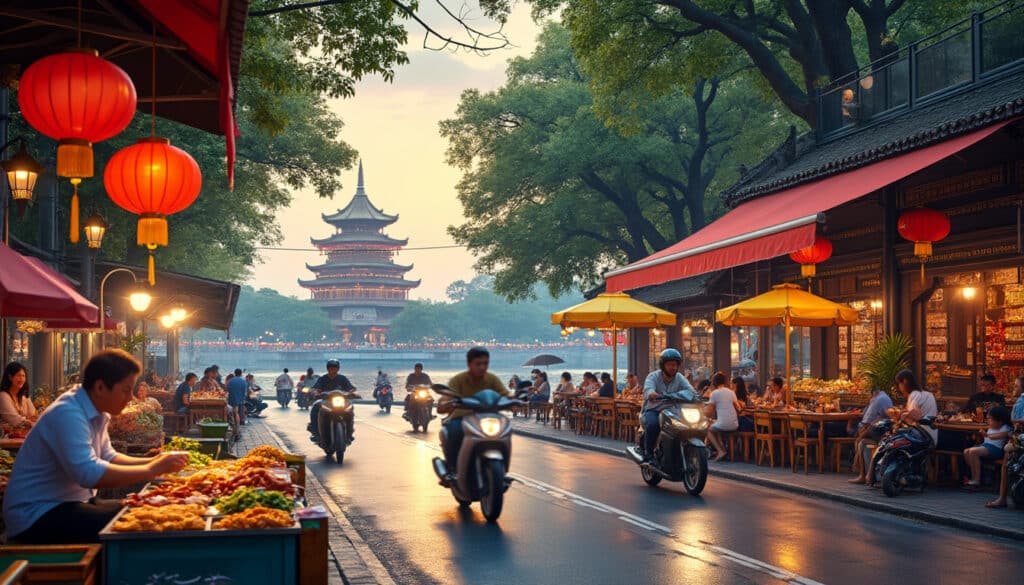
Fun Facts & Curiosities About Hanoi
Hanoi, the vibrant capital of Vietnam, is a fascinating mix of rich history, unique traditions, and modern progression. From its celebrated street food scene to the captivating water puppet shows, Hanoi is both a city of lakes and legends. Visitors…
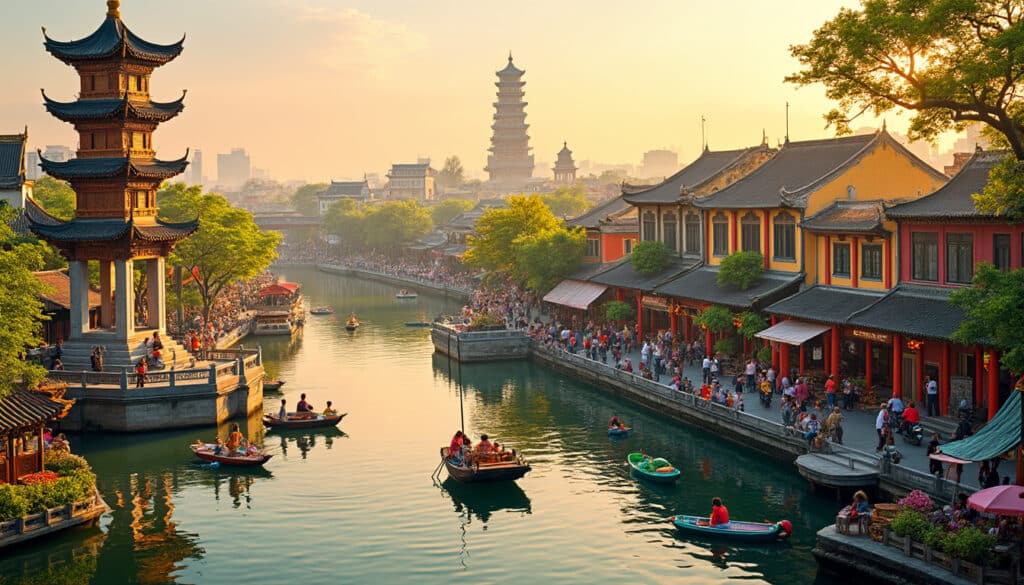
Architecture and urban features of Hanoi
With a rich tapestry of cultures and historical evolution, Hanoi stands as a captivating testament to Vietnam’s architectural diversity. This city’s allure doesn’t just lie in its remarkable history but in its unique blend of oriental and French-style architecture that…
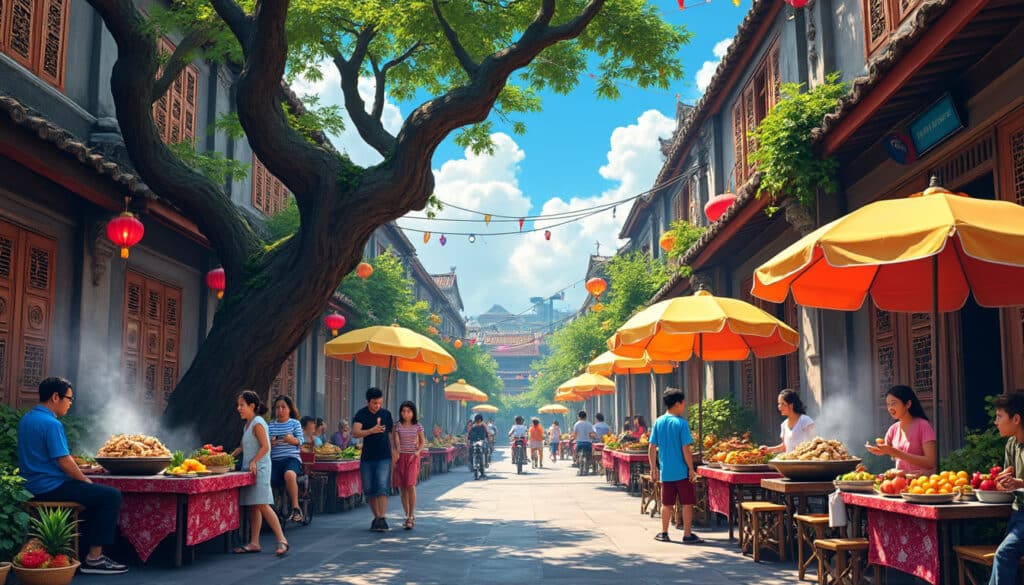
Experience the daily life in Hanoi, a city brimming with vibrant charm and historical depth. As you navigate through the bustling streets, the harmonious blend of the old and new reveals itself in every corner. From savoring delectable street food…
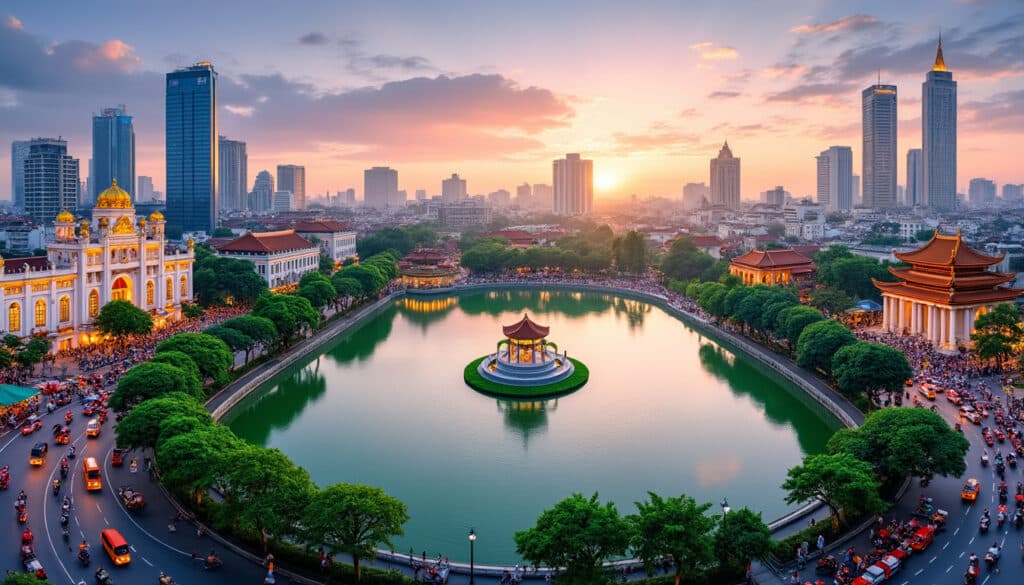
Demographics and geography of Hanoi
The vibrant city of Hanoi, the capital of Vietnam, is not just the political heart but also a pulsating hub of culture, history, and modernity. With a rich tapestry of over a thousand years of evolution, the city has seen…

Holidays and celebrations in Hanoi
Hanoi, the pulsating heart of Vietnam, offers a tapestry of vibrant festivals and celebrations that reflect its rich cultural heritage and traditions. Throughout the year, local and international visitors witness an enchanting blend of the past and present, as the…

Language and spelling of Hanoi
Hanoi, the vibrant capital of Vietnam, is a melting pot of cultures, histories, and languages. It’s not just a city known for its charming architecture or vibrant street life, but also for its linguistic diversity that reflects its historical tapestry.…

Local tips for tourists in Hanoi
Exploring Hanoi, Vietnam’s thousand-year-old capital, is a journey into a world where ancient traditions and modern dynamism converge. With its rich cultural heritage, vibrant street life, and aromatic cuisine, Hanoi captivates every traveler. Yet, navigating this bustling city can be…

Reputation and identity of Hanoi
As the capital city of Vietnam, Hanoi’s reputation and identity intertwine richly with its historical and cultural legacies. Emblematic for its historic architecture, street food, and melodious water puppet shows, the city pulsates with the quintessential Vietnamese spirit. From its…

As the vibrant capital of Vietnam, Hanoi is a city that offers an intriguing blend of history, modernity, and cultural diversity. Understanding the rhythm of this bustling metropolis goes beyond its rich traditions and lively street scenes. The way time…

Unusual facts and social issues in Hanoi
Hanoi, the bustling capital of Vietnam, is a city that fuses ancient traditions with rapid modernity. Known for its rich cultural heritage, Hanoi’s unique blend of history and progression offers a fascinating backdrop for unusual facts and social dynamics that…
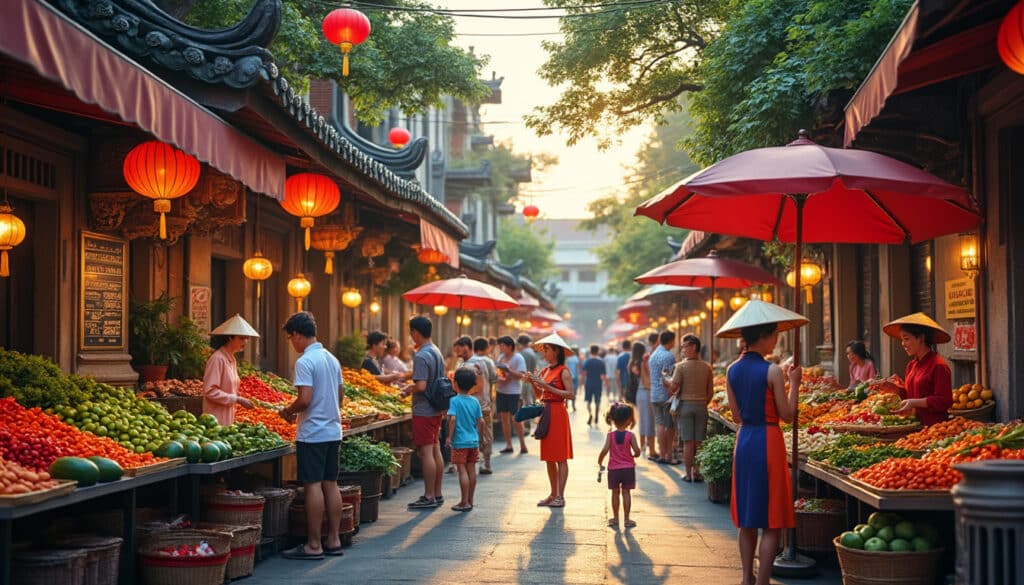
What does Hanoi look, smell, feel like?
Experiencing Hanoi is like stepping into a symphony of vibrant images, lively sounds, and delightful scents. Nestled between historic roots and modern hustle, Vietnam’s capital offers a unique sensory journey. Whether you’re wandering through the alleys brimming with local art…



